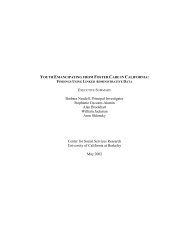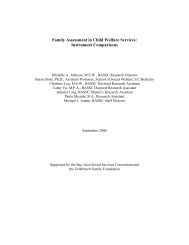Developing a Self-Assessment Toolfor Culturally - Office of Minority ...
Developing a Self-Assessment Toolfor Culturally - Office of Minority ...
Developing a Self-Assessment Toolfor Culturally - Office of Minority ...
Create successful ePaper yourself
Turn your PDF publications into a flip-book with our unique Google optimized e-Paper software.
under the three core functions <strong>of</strong> public health 3 require effective and meaningfulcommunication, between LPHAs and the community (Harrell 1994).LPHAs that provide CLAS accommodate differences in language and culture and<strong>of</strong>fer language assistance services such as interpreters or bilingual providers. LPHAs alsomay provide staff with cultural diversity training and provide clients with culturallysensitive health care services. Together, these services may improve health and decreasedisparities, because health care providers increase their ability to understand and treat aculturally diverse clientele with varied health beliefs and practices, thus improvingaccuracy <strong>of</strong> diagnoses and selection <strong>of</strong> appropriate treatment (Becker 1980).1.4 PROJECT BACKGROUND AND OBJECTIVESIn 1983, the annual issue <strong>of</strong> Health, United States (the report card on the health status<strong>of</strong> the American people) documented significant progress in the overall health picture <strong>of</strong>the Nation (National Center for Health Statistics NCHS 1983). The report reinforced thefact that there were continuing disparities in the burden <strong>of</strong> death and illness experienced byracial and ethnic minority Americans as compared with the U.S. population as a whole—adisparity that has existed ever since accurate federal record keeping began more than ageneration ago. In response to the report findings, a Task Force was established by the thenSecretary <strong>of</strong> DHHS to investigate the health problems <strong>of</strong> African Americans, NativeAmericans, Hispanics, and Asian/Pacific Islanders. The Task Force was charged withreviewing and analyzing the departmental programs and range <strong>of</strong> resources available toaddress the health problems <strong>of</strong> racial and ethnic minorities, and with recommending waysfor the department to exert leadership, influence, and initiative to close the existing gaps.The result <strong>of</strong> the Task Force’s efforts and deliberations was presented to the Secretaryin August 1985 in the “Report <strong>of</strong> the Secretary’s Task Force on Black and <strong>Minority</strong> Health”(Heckler 1985). This report subsequently led to the establishment <strong>of</strong> OMH in 1986 withinthe <strong>Office</strong> <strong>of</strong> the Assistant Secretary for Health (now the <strong>Office</strong> <strong>of</strong> Public Health andScience), headed by the Deputy Assistant Secretary for <strong>Minority</strong> Health. That<strong>Office</strong>—which was legislatively established under the Disadvantaged <strong>Minority</strong> HealthImprovement Act <strong>of</strong> 1990 (Public Law 101-527) and reauthorized under the Health3 Essential public health services include: monitor health status to identify community health problems;diagnose and investigate health problems and health hazards in the community; inform, educate, and empowerpeople about health issues; mobilize community partnerships to identify and solve health problems; developpolicies and plans that support individual and community health efforts; enforce laws and regulations thatprotect health and assure the provision <strong>of</strong> health care when otherwise unavailable; link people to neededpersonal health services and assure the provision <strong>of</strong> health care when otherwise unavailable; assure acompetent public health and personal health care workforce; evaluate effectiveness, accessibility, and quality<strong>of</strong> personal and population-based health services; and conduct research for identifying new insights andinnovative solutions to health problems (Public Health Functions Steering Committee 1995).COSMOS Corporation, December 2003 1-5
















